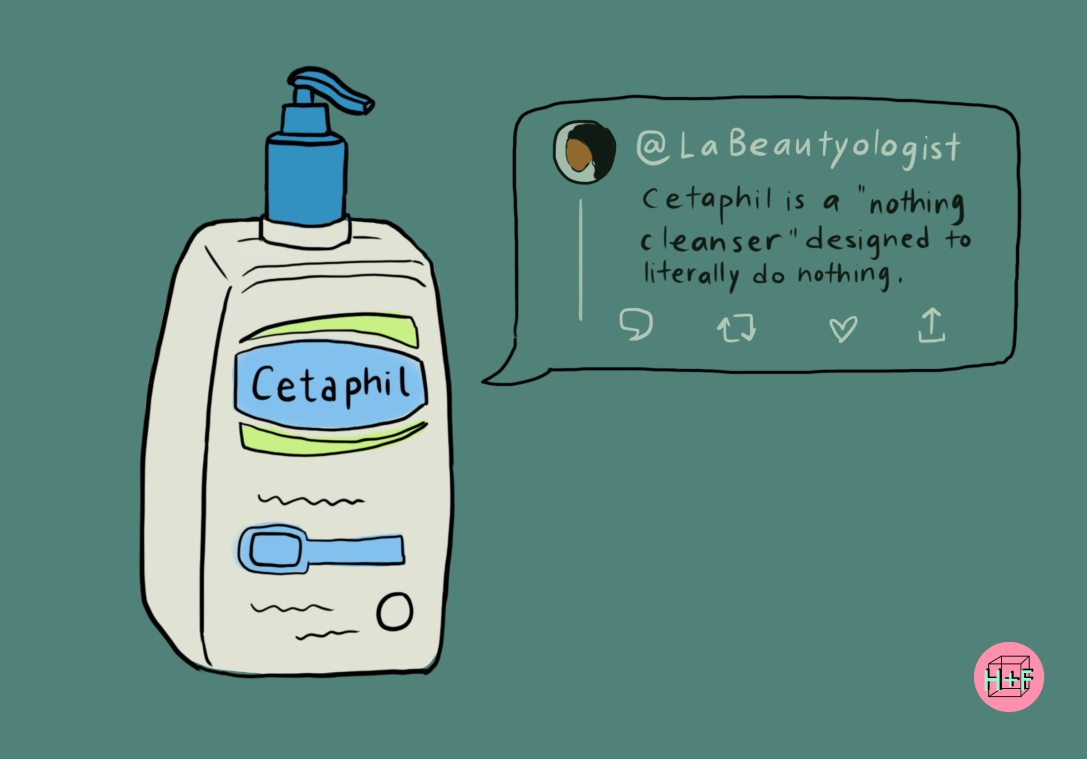I recently ran out of my holy grail cleanser Tatcha Deep Cleanse, and I was forced to use my mom’s Cetaphil cleanser. This only brought back all the things I despise about this cleanser. If you have oily skin (really oily like me), this cleanser does absolutely nothing. I still feel a layer of oil sitting on top of my skin even after using the facewash 3x times in a row. I started to question if the cleanser even has any active ingredients. Are they just trolling us? Selling us thickened water?
Many dermatologists apparently promote the use of Cetaphil. Okay, so why do so many professionals promote this? Well, maybe the fact that this cleanser does nothing is why they like Cetaphil. A lot of times topical medications are very harsh on the skin, so the last thing they want is a cleanser that further deteriorates the skin’s integrity.
I tried to find other people’s thoughts about this useless cleanser, and there are people that go as far as saying Cetaphil is the “devil”…Okay, I know my distaste for Cetaphil is a bit harsh but surely Cetaphil isn’t demonic? And hence begins the nosedive into Cetaphil: WHAT INGREDIENTS EVEN MAKE THIS QUALIFY AS A CLEANSER and IS IT SECRETLY EVIL?

Cetaphil Sensitive Skin Cleanser has 8 ingredients (pictured above).
- Water
- Cetyl alcohol
- Fun fact: was first isolated from sperm whales.
- Acts as thickening/binding agent, emollient (moisturizer), and emulsifier (remove oil) [1]
- Propylene glycerol
- Humectant (retain moisture) [2]
- Sodium lauryl sulfate
- Emulsifier (remove oil)
- Surfactant that is also found in cleaning products.
- Absorbs into the bloodstream. HOWEVER, CIR and other reviews found no evidence of SLS accumulating in organs to toxic levels [3]
- Stearyl alcohol
- Emulsifier (remove oil), also prevents foaming [4]
- Methylparaben, butylparaben, propylparaben
- Parabens act as a preservative that prevents growth of harmful microbes.
- There are studies that link parabens and development of cancer or tumours. [5] HOWEVER, association is not always causation.
- CIR does report low order of toxicities in paraben levels used in cosmetics [5]. While this may cause some people to squeal in fear, have you ever considered other sources of parabens? You might even consume parabens elsewhere, like in pickles or beer. Trust me, you aren’t going to get cancer if you ever used Cetaphil, nor if you decide to finish that tube of Maybelline mascara.
In conclusion, cetaphil is not EVIL.
I am not here to argue with advocates of natural cosmetics either because at the end of the day, I still despise this cleanser. From my deduction, this cleanser is lacking an exfoliant. For a gal with more oily complexion, this cleanser is one that does not accomplish the one thing that it sets out to do. If you are concerned about parabens, find another cleanser! There are so many out there, like Tatcha, that use alternatives.
This might be one of the most random posts I’ll ever make. Or it might be the start of something new because lately my stream of thoughts takes me on deep nosedives. Hope you enjoyed reading about all the random information I have collected. I encourage everyone to look for reliable information before making a judgement. For example, actually doing research instead of relying on words of lifestyle bloggers. (hmm, I wonder why all these blogs think Cetaphil is evil). Research may not always be easy, thus I think it is crucial to seek information from multiple platforms that offer diverse perspectives on a certain topic.
🤡 Keep learning and talk to you all later! 🤡
My sources (in a not-so-formal format):
- https://www.chemicalsafetyfacts.org/cetyl-alcohol/
- https://www.atsdr.cdc.gov/phs/phs.asp?id=1120&tid=240; https://cosmeticsinfo.org/ingredient/propylene-glycol
- https://www.ncbi.nlm.nih.gov/pmc/articles/PMC4651417/
- https://cosmeticsinfo.org/ingredient/stearyl-alcohol
- https://www.scientificamerican.com/article/should-people-be-concerned-about-parabens-in-beauty-products/; https://www.ncbi.nlm.nih.gov/pubmed/19101832

